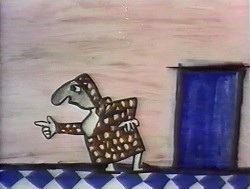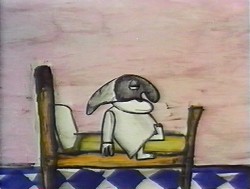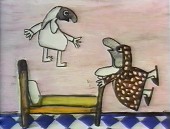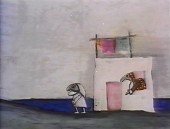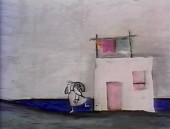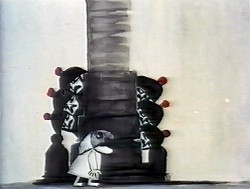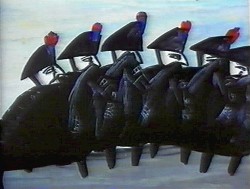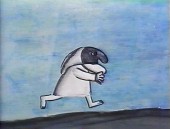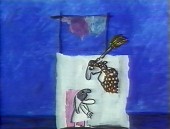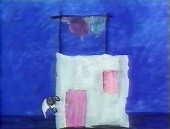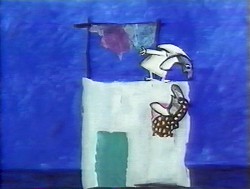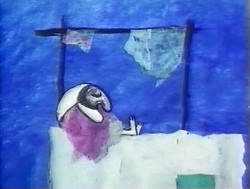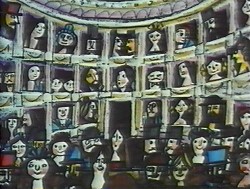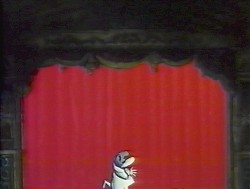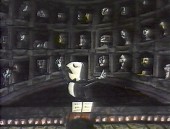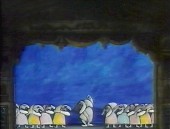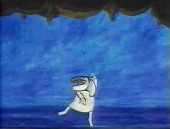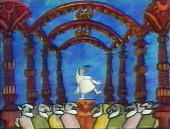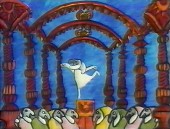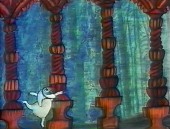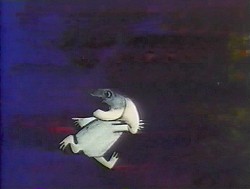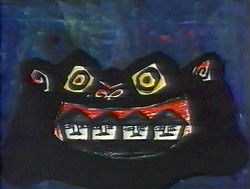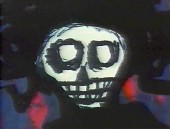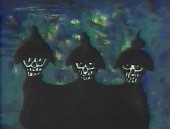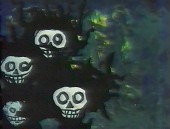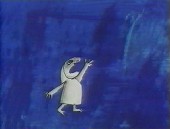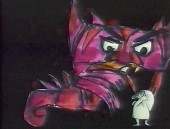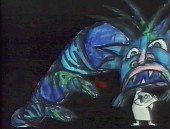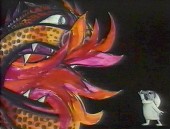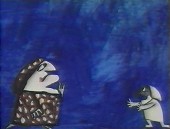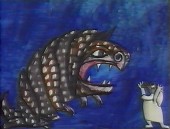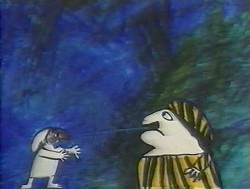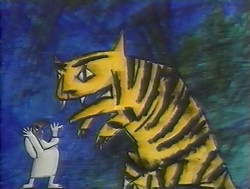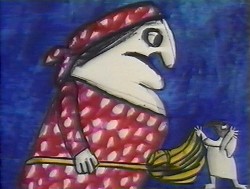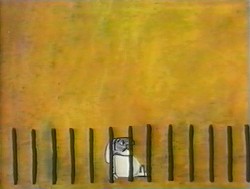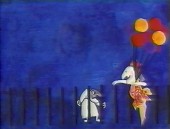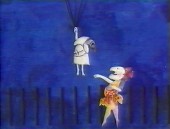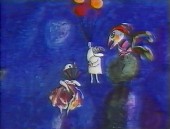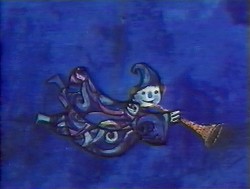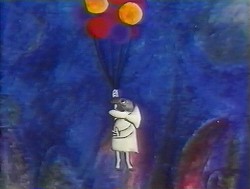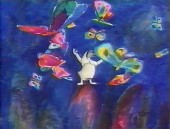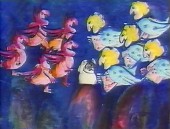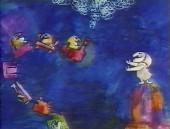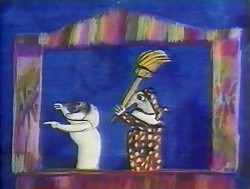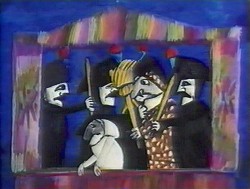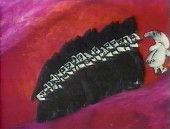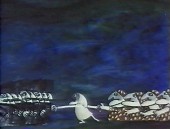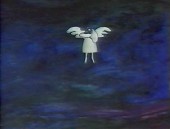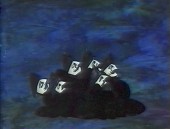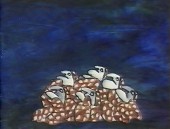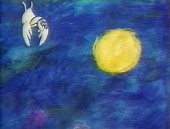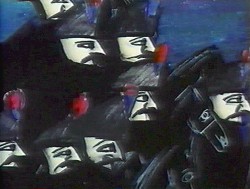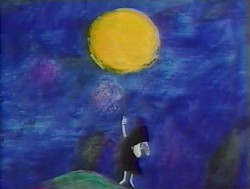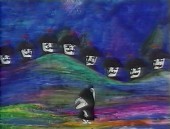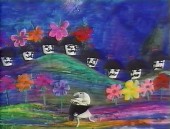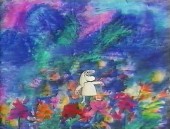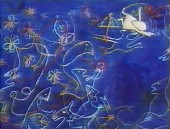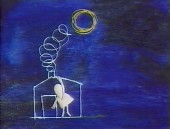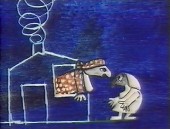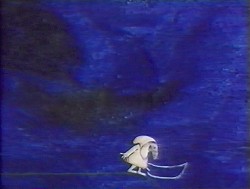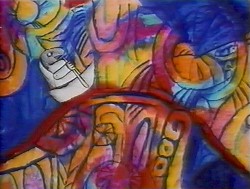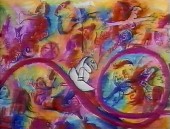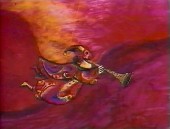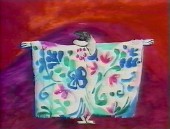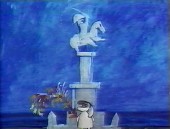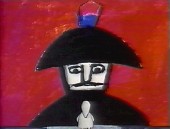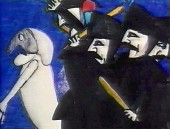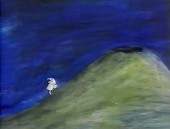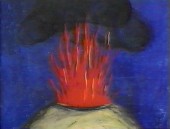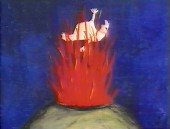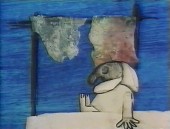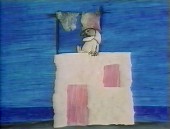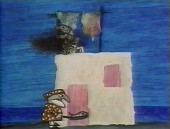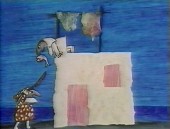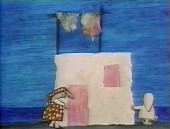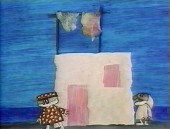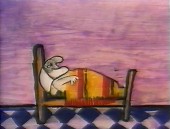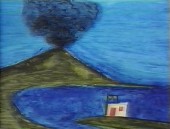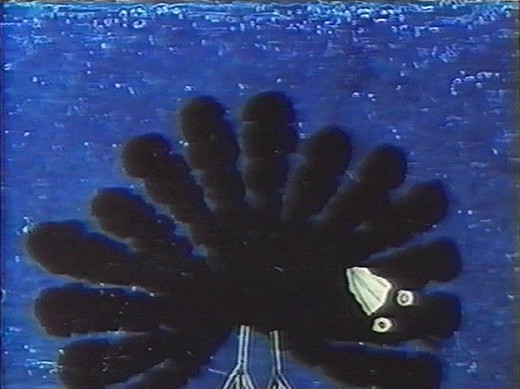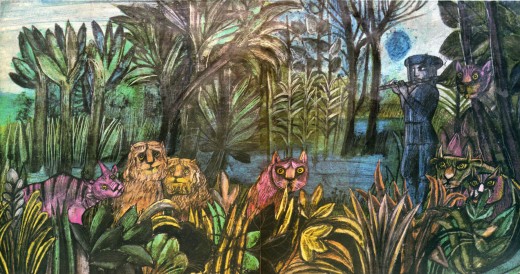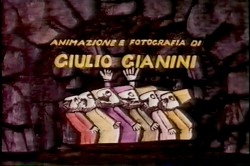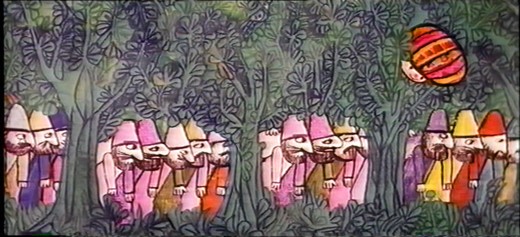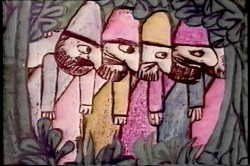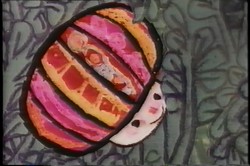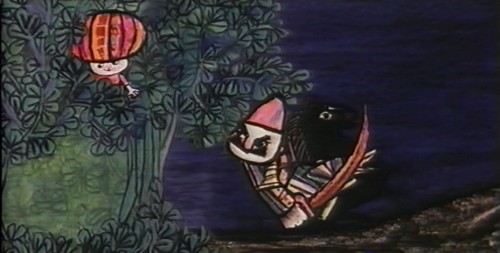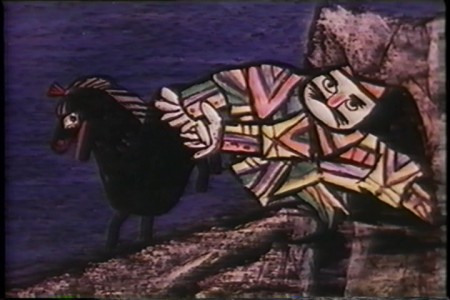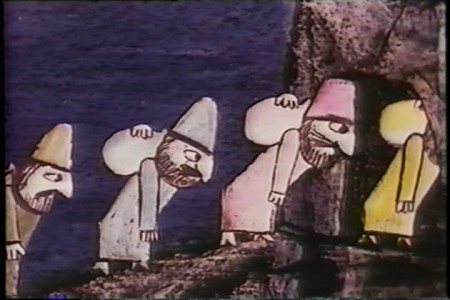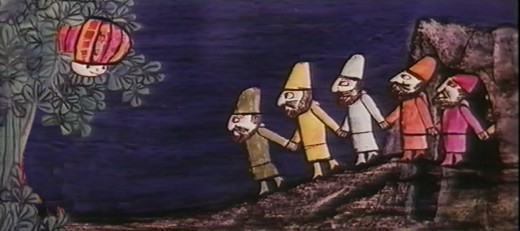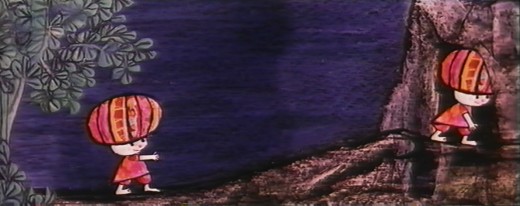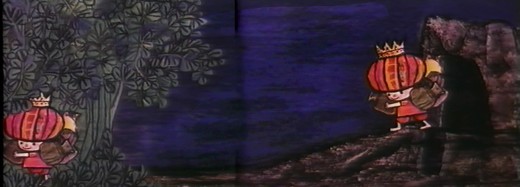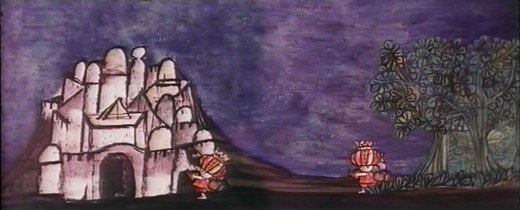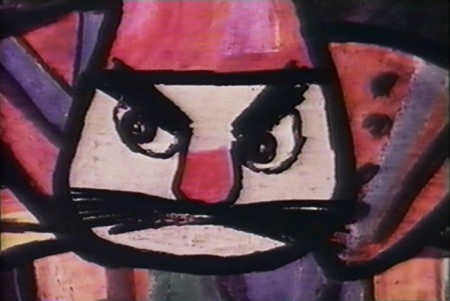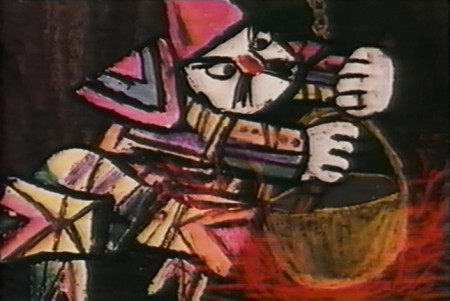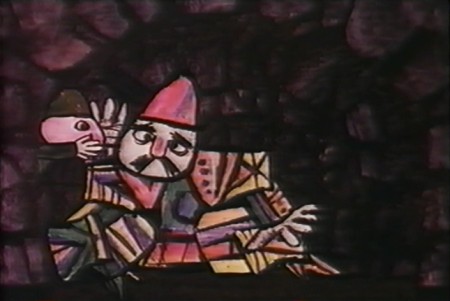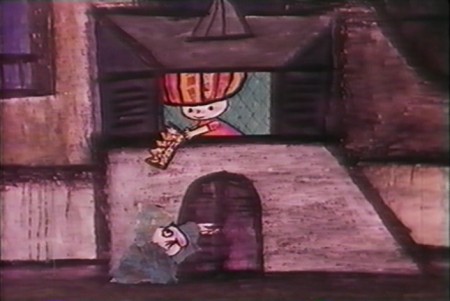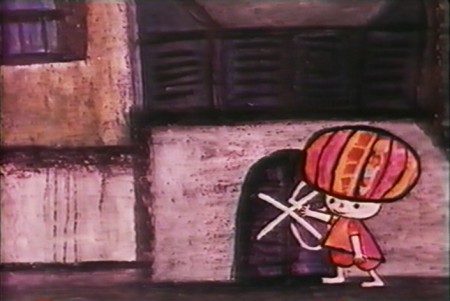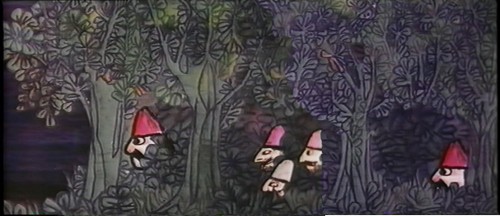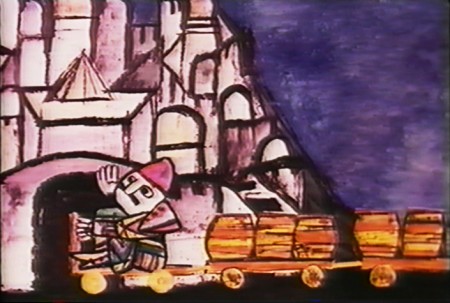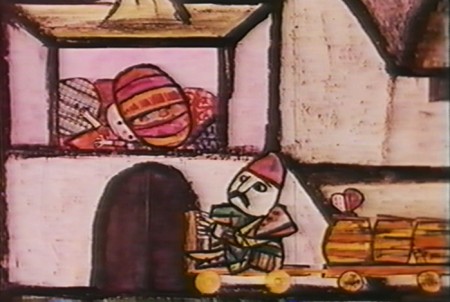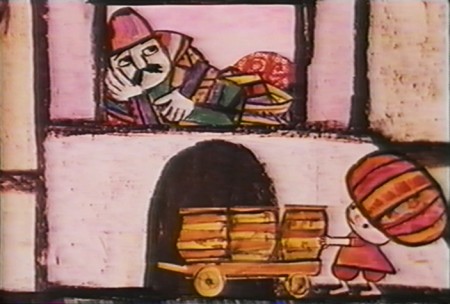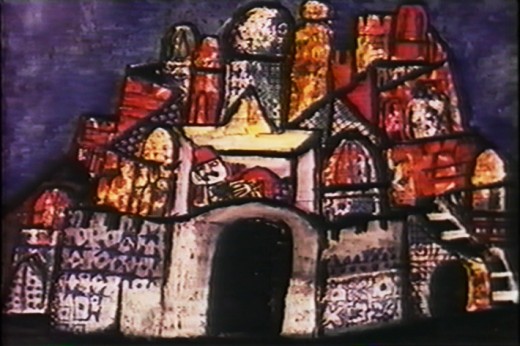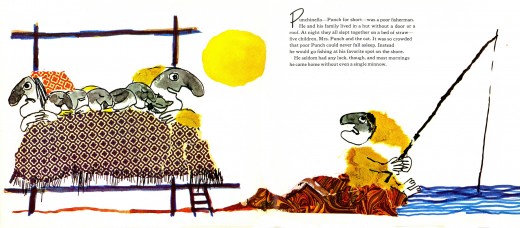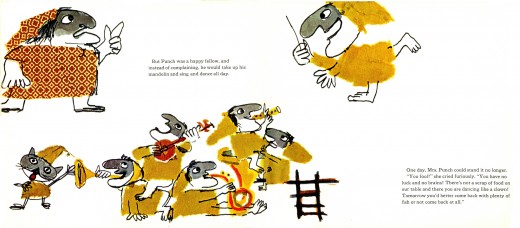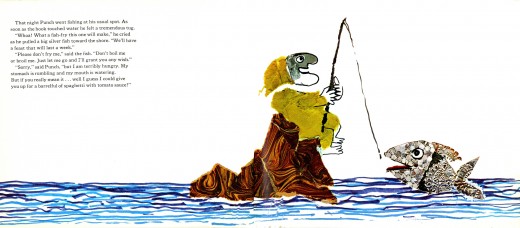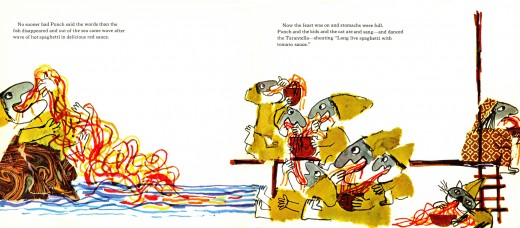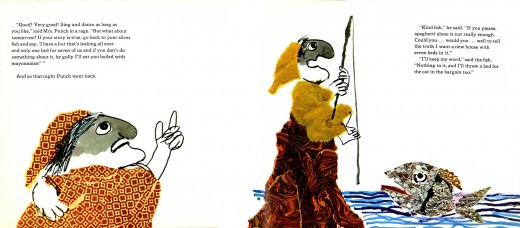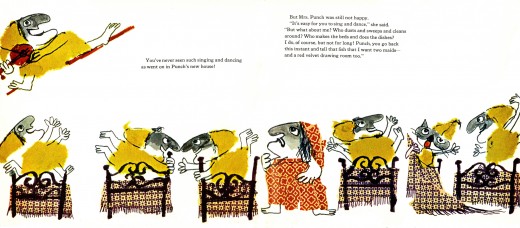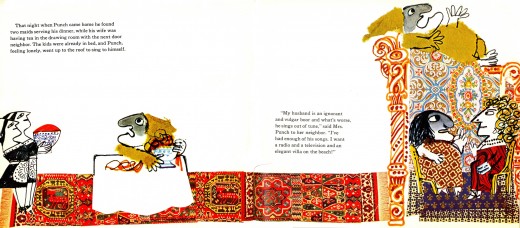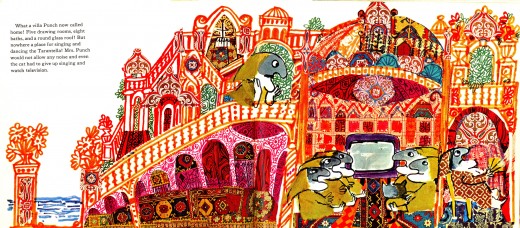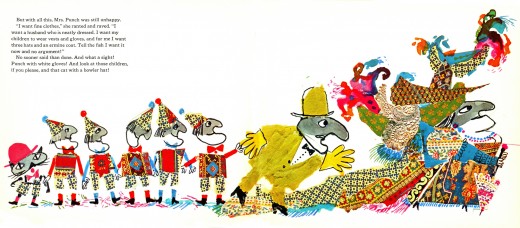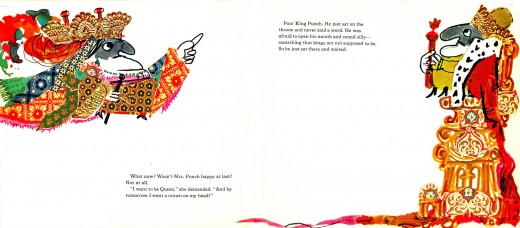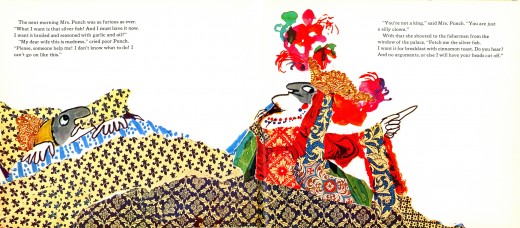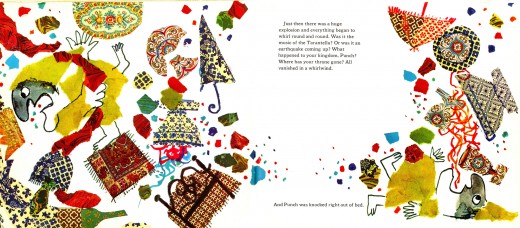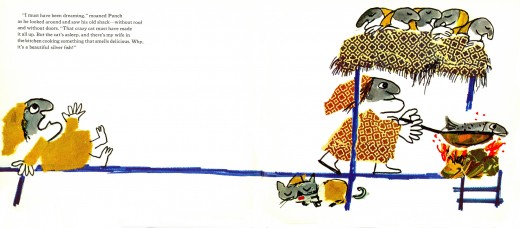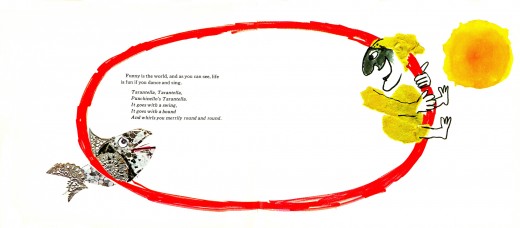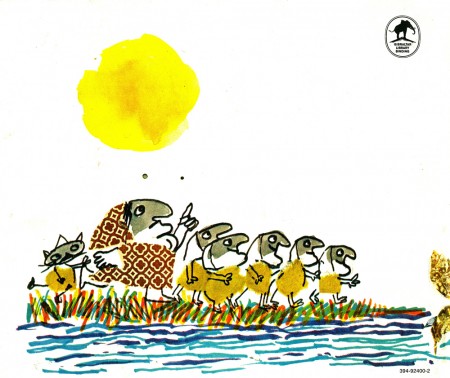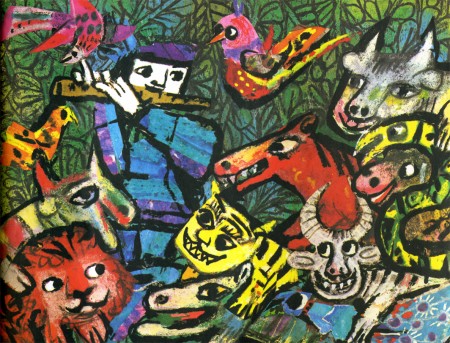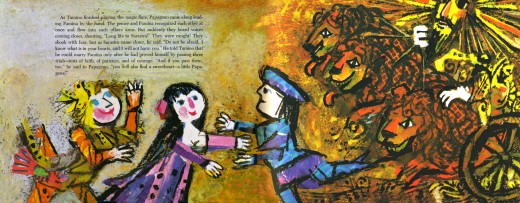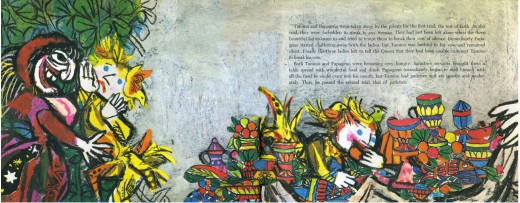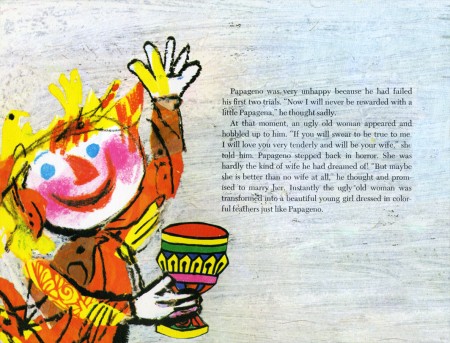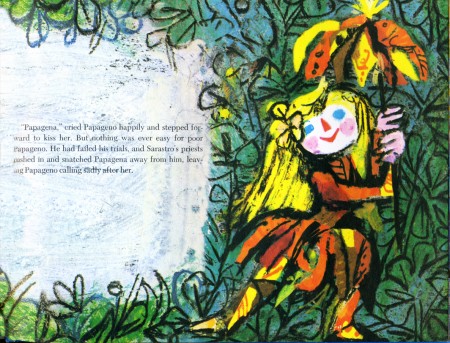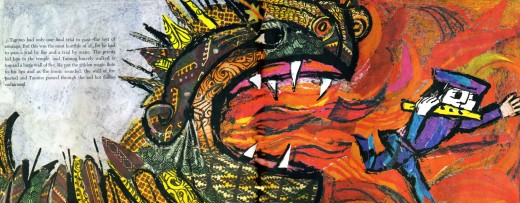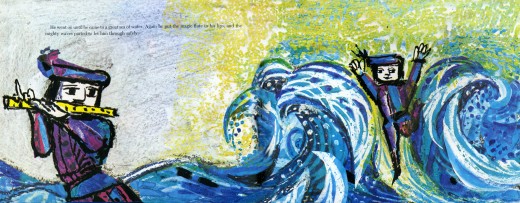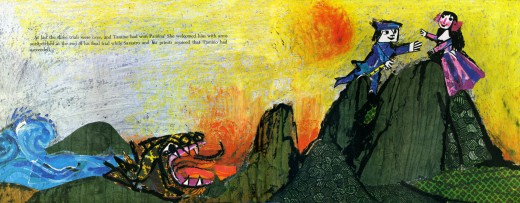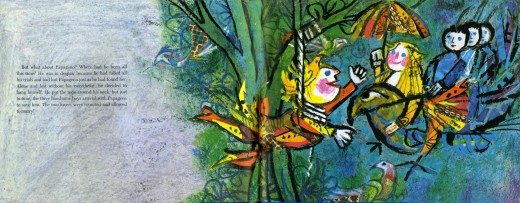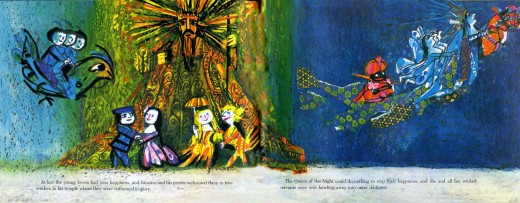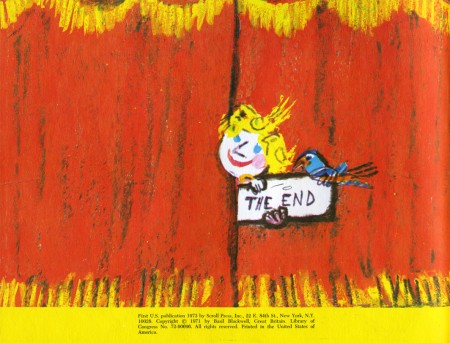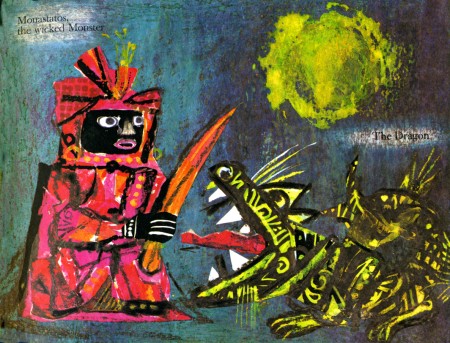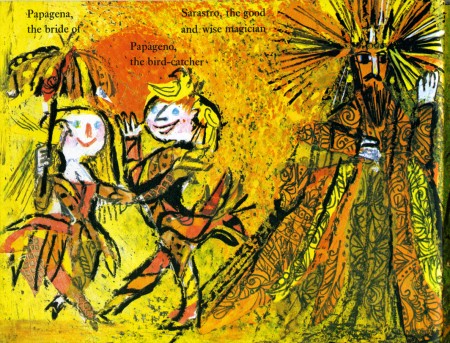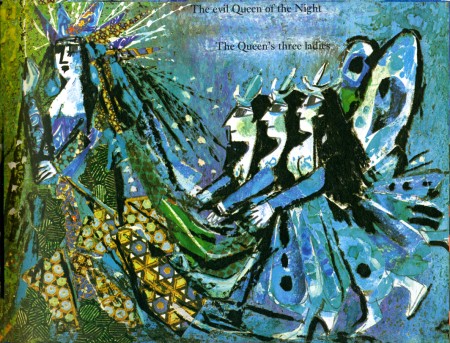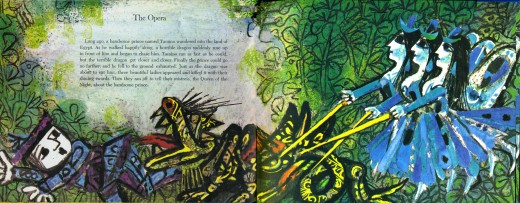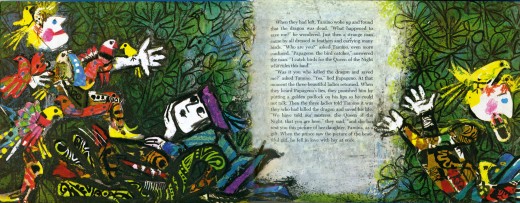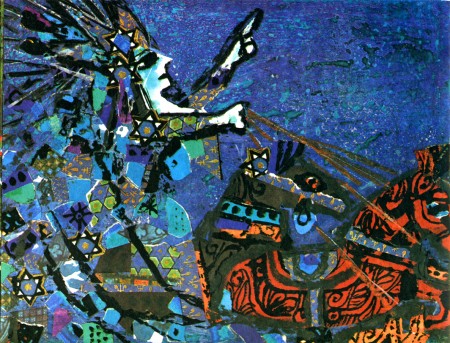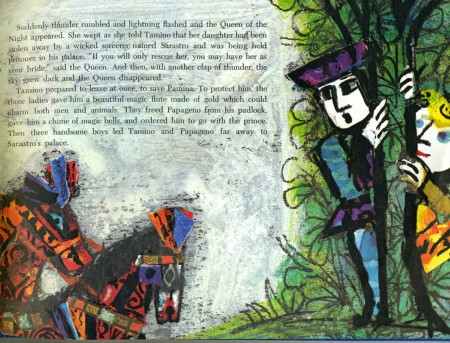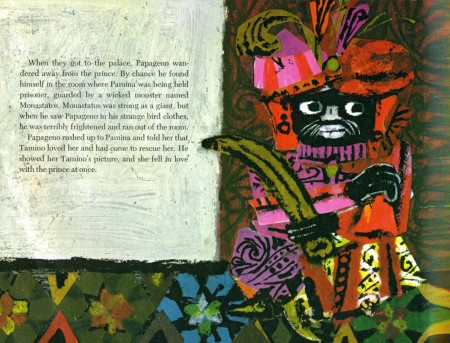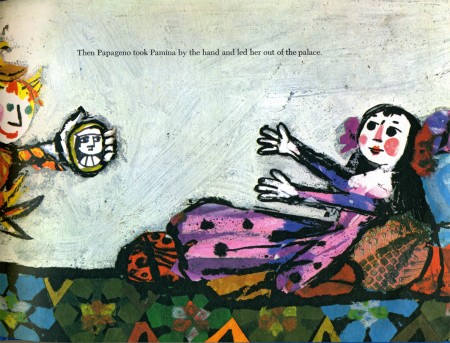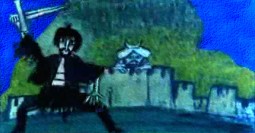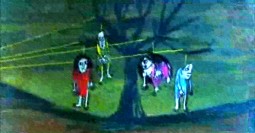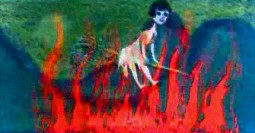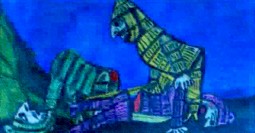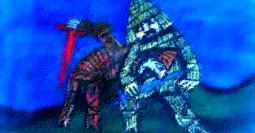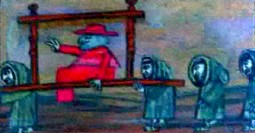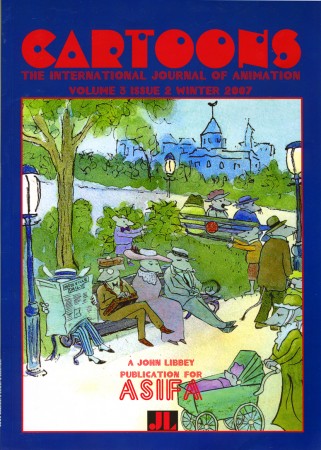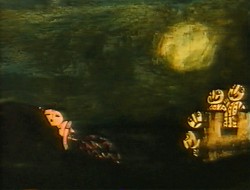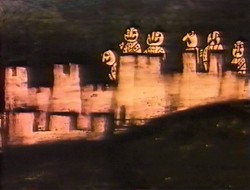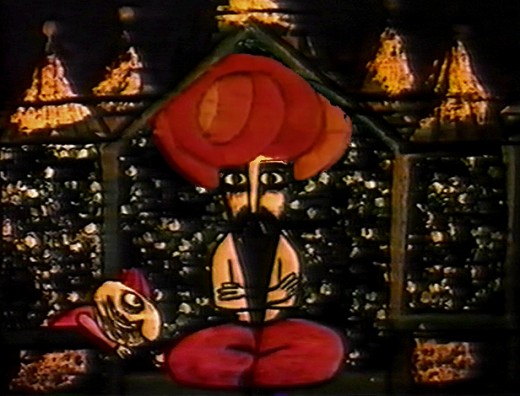Category ArchiveLuzzati & Gianini
Animation &Articles on Animation &Luzzati & Gianini &repeated posts 02 Oct 2012 04:59 am
Luzzati & Gianini
- I spent some time rereading some material about Emanuele Luzzati and Giulio Gianini. I went back into my archives and found a lot of frame grabs and a bit of info about them at the time of their individual deaths. Ive put three of those posts together and am posting that today as sort of a retrospective piece.
Luzzati
Jan. 26th, 2007
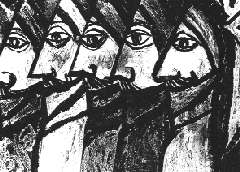 Emanuele Luzzati has died. He was the brilliant Italian designer, who worked with Giulio Gianini in creating some wonderful animated cut-out films.
Emanuele Luzzati has died. He was the brilliant Italian designer, who worked with Giulio Gianini in creating some wonderful animated cut-out films.
Their films adapted operatic overtures in reworking the operas themselves. The two were nominated for the Oscar for “The Thieving Magpie,” done in 1965 an interpretation of Rossini’s opera and again in 1973 for “Pulcinella.”
Luzzati died Jan. 26th, 2007 on the way home from work. He collapsed just outside his home. He hadn’t been ill prior to this. He spoke on the phone with Giulio Gianini, who has been very ill for some time, that very morning.
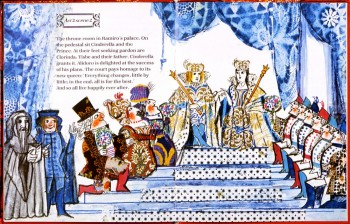 Luzzati designed sets and costumes for stage productions and operas, including the 1963 production he designed for Mozart’s “The Magic Flute.” Fifteen years later he turned the opera into an animated feature that remains one of his most famous works.
Luzzati designed sets and costumes for stage productions and operas, including the 1963 production he designed for Mozart’s “The Magic Flute.” Fifteen years later he turned the opera into an animated feature that remains one of his most famous works.
He’s illustrated and written quite a few books. See this list on Amazon.
(Above: an image from his children’s book, Cinderella.)
The only Obituary I’ve seen for him was this one for the AP. It does give rather complete details of his life and work. AP Obituary.
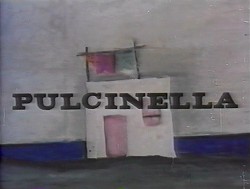 – I received a call from The Guardian in London. The newspaper was doing an obituary for Emanele Luzzati, and they couldn’t find any illustrations to color their report. They’d found some on my blog and wanted to know if they could use them.
– I received a call from The Guardian in London. The newspaper was doing an obituary for Emanele Luzzati, and they couldn’t find any illustrations to color their report. They’d found some on my blog and wanted to know if they could use them.
(Go here to see all Luzzati/Gianini posts.)
Of course, I directed them to Luzzati‘s distributor who could give the clearances they needed.
But I found it all depressing.
This was one of the world’s greatest designers of Operas and Animation. His brilliant animated version of The Magic Flute is a feature that should be in theaters now. Unfortunately, it never made it to theaters (at least, not in the US), and his designs for the opera are equally as stunning.
Years of amazing art he’s produced, and there’s so little – even on-line – that could be readily found for his obituary. I find it confusing. This was the original reason I had for putting so much attention on his work, and the call from the paper pushes me back to do another post. Unfortunately, all I have are frame grabs.
Here is Pulcinella. It is a short that was nominated for the Oscar in 1973. Another cut-out animated film, Frank Film by Frank and Caroline Mouris won the award. The Legend of John Henry by Sam Weiss, produced by Nick Busustow was also nominated.
Like other Luzzati/Gianini films, the score is taken from an opera overture, Rossini’s The Turk in Italy.
The animated film is an abbreviated, caricatured version of the opera. 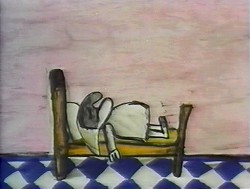
Pulcinella (Punch, as in Punch & Judy) is the principal character who dreams himself into a wild nightmare of a dream that leads us through an abstract world. It’s nice to see how the animators/designers play off the puppet character as well as the opera.
I’m just going to post the images without detailing the story. I like it better that way.
There are some 90 images, so it takes some attention to graphics.
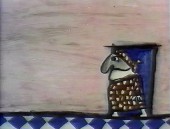
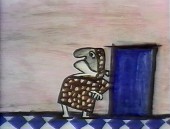
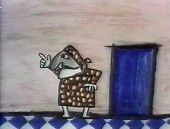
(Click any image on the page to enlarge.)
Gianini
May 18th, 2009
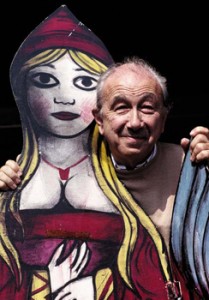 – I’ve been something of a fan of the films of Luzzati and Gianini. I’d met Emanuelle Luzzati at a function thrown at the Italian Embassy in New York, years ago. I bought a book by him, and the artist drew a beautiful pen and ink drawing in the frontispiece of the book.
– I’ve been something of a fan of the films of Luzzati and Gianini. I’d met Emanuelle Luzzati at a function thrown at the Italian Embassy in New York, years ago. I bought a book by him, and the artist drew a beautiful pen and ink drawing in the frontispiece of the book.
In 1988, I met Giulio Gianini in Italy during a stay of a couple of pleasant days with an assistant of his at the festival in Treviso, Italy.
Mr. Gianini died this past Saturday, and I wanted to offer a bit of a memorial. Emanuelle Luzzati died January, 2007 and to memorialize that I posted some illustrations and information about the duo with a lot of frame grabs from a number of the Luzzati/Gianini films. It took a few posts, and I left off without wanting to overplay all of the art at my availability.
Luzzati & friend
The Thieving Magpie was the first of their films to receive an Oscar nomination, and it was the first of the frame-grab posts I showcased. I’d like to post it again in honor of Mr. Gianini. He was sick for several years and in particularly bad condition. His death wasn’t a surprise, but it is still an enormous loss.
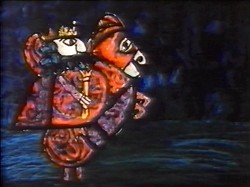 1
1 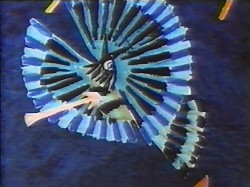 2
2(Click any image to enlarge.)
La Gazza Ladra (The Thieving Magpie) is a Rossini opera about a young maidservant who, accused of stealing a silver spoon, is sentenced to death for her crime.
At the eleventh hour, the real culprit is found to be a magpie.
A cartoon, if ever there was one. With great music!
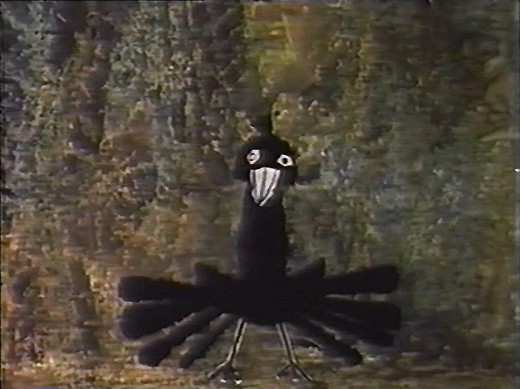
The film tells a tale wherein a king and his hunters, on a bird hunt, are beaten
by a magpie who steals their gems and ultimately destroys their village.
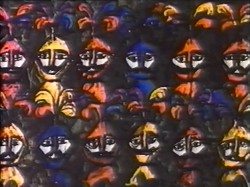 4
4 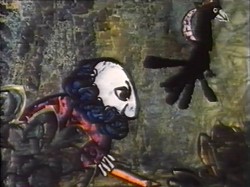 5
5
Luzzati who spent many years designing operas and ballets,
brought his knowledge to animation as the pair adapted several operas often utilizing the overtures of the operas they were adapting.
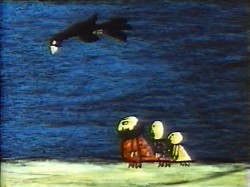 6
6 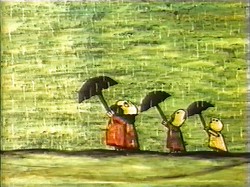 7 The film was nominated in 1964 along with
7 The film was nominated in 1964 along with
Clay, and the Origin of the Species by Eliot Noyes
and the winner, Chuck Jones’ Dot and the Line.
The Sound of Music won the Best Picture Oscar, that year.
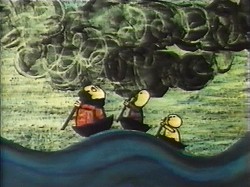 8
8 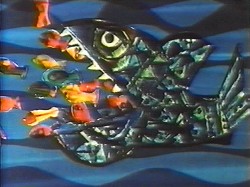 9 The use of cut-out animation wasn’t mainstream at the time.
9 The use of cut-out animation wasn’t mainstream at the time.
This is years before Terry Gilliam made it somewhat fashionable. All of the
Luzzati-Gianini films were totally inventive and creative within the form they established.
Gianini’s animation was as dreamlike as Luzzati’s exciting designs. The films
look to be designed somewhere between Chagall, Kirchner and
stained-glass windows; the sensibilities are all Luzzati and Gianini.
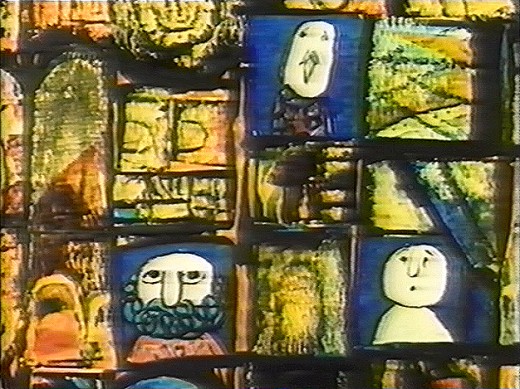 Today we have Flash animation which does just about the same thing as cut-out animation, but the form used today is flat and vulgar and cartoony. It might be useful for practitioners of Flash to take a good look at what these two brilliant designer/animators did with a similar form under more complex and arduous methods. Ulltimately, it’s all related.
Today we have Flash animation which does just about the same thing as cut-out animation, but the form used today is flat and vulgar and cartoony. It might be useful for practitioners of Flash to take a good look at what these two brilliant designer/animators did with a similar form under more complex and arduous methods. Ulltimately, it’s all related.
You can get a bit more information about Gianini and Luzzati from the website of the Luzzati Museum in Genova.
Articles on Animation &Luzzati & Gianini &Puppet Animation 22 Jun 2010 07:08 am
Magic Flute
Issue #7 of ANIMAFILM included an article about the Gianini/Luzzati feature, The Magic Flute. To keep the names of these greats in the present, I’m posting the article here. Enjoy.
by Massimo Maisetti
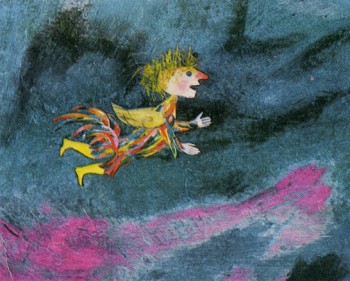 The “Magic Flute” was Mozart’s last opera, written not for the court theatre in the centre of Vienna, but for a theatre situated at the outskirts, whose manager was Schikaneder, author of the libretto. Giorgio Strehler said that it was one of the most complex and most universal works, which could be approached both from the position of the performer and the spectator. The libretto, inspired by oriental short stories, published in 1786, and by abbot Terrason’s novel, stirs up imagination, intelligence, feelings and the sense of ethics. Goethe wrote that one needed more culture to admit the values of the libretto than to deny their existence. This opinion should be thought over, as it deals with the performance staged at the outskirts in the period when to acknowledge values of a “folk” work was to oppose the accepted norms.
The “Magic Flute” was Mozart’s last opera, written not for the court theatre in the centre of Vienna, but for a theatre situated at the outskirts, whose manager was Schikaneder, author of the libretto. Giorgio Strehler said that it was one of the most complex and most universal works, which could be approached both from the position of the performer and the spectator. The libretto, inspired by oriental short stories, published in 1786, and by abbot Terrason’s novel, stirs up imagination, intelligence, feelings and the sense of ethics. Goethe wrote that one needed more culture to admit the values of the libretto than to deny their existence. This opinion should be thought over, as it deals with the performance staged at the outskirts in the period when to acknowledge values of a “folk” work was to oppose the accepted norms.
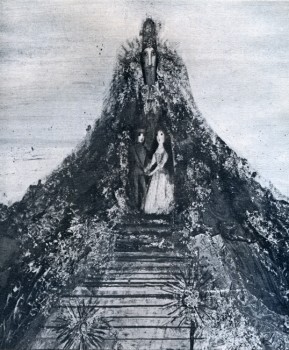 The opera, performed for the first time on September 30th, 1791, has many elements aimed at entertaining less sophisticated audience. Next to the drama of Tamino and Pamina, which is the embodiment of the eternal conflict between Right and Wrong, the Sun and Darkness, next to esoteric elements, connected with the doctrine of freemasons, which both Mozart and Schikaneder professed, there is a counterpoint – Papageno, a purely folk character from commedia dell’arte. The opera has many aspects, but the most visible ones are its fabulous and folk aspects, and next to them – metaphysical, symbolic and cosmic aspects with their Egyptian and Hellenistic associations, making one “gravitate towards one’s conscience”, according to Kirkegaard’s words. Thus to screen the “Magic Flute” was a very difficult task, as the authors of the film rejected the possibility of screening the theatre performance. It was also difficult because they had to use a chromatic and graphic language, animating drawings, where culture and experience should be combined with great sensitiveness and invention.
The opera, performed for the first time on September 30th, 1791, has many elements aimed at entertaining less sophisticated audience. Next to the drama of Tamino and Pamina, which is the embodiment of the eternal conflict between Right and Wrong, the Sun and Darkness, next to esoteric elements, connected with the doctrine of freemasons, which both Mozart and Schikaneder professed, there is a counterpoint – Papageno, a purely folk character from commedia dell’arte. The opera has many aspects, but the most visible ones are its fabulous and folk aspects, and next to them – metaphysical, symbolic and cosmic aspects with their Egyptian and Hellenistic associations, making one “gravitate towards one’s conscience”, according to Kirkegaard’s words. Thus to screen the “Magic Flute” was a very difficult task, as the authors of the film rejected the possibility of screening the theatre performance. It was also difficult because they had to use a chromatic and graphic language, animating drawings, where culture and experience should be combined with great sensitiveness and invention.
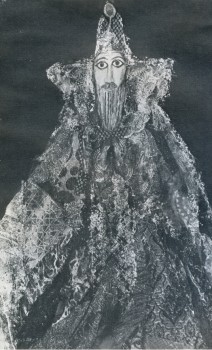 Giulio Gianini and Emanuele Luzzati are among the few film-makers in the world, who can perform such a task successfully. Gianini is an animator. He is an organizer, who is able to subordinate the technique to creative requirements. His characters move like puppets against the scenography. Its colour scheme is joy, music and charm. Those colours are the invention of the scenographer Luzzati, and Gianini, the master of photography (Nastro d’Argento for best colour photography in 1952), can reproduce them using his miraculous alchemic recipes. It was not a mere chance that many years ago at the Festival in Gildenbourgh he worked on Mo/art’s operas: “Don Juan”, “Abduction from Serai”, “Cos! fan Tutte” and “Magic Flute”. “I have always wanted to make such a film since the day I worked on that scenography”, says Luzzati. Twelve years of preparations, two years of work financed by the German and Austrian television, work done with patience, skill and imagination. At least three of Gianini’s and Luzzati’s films, first films of that kind, are characterized by a perfect relation between the music and the image: “La Gazza ladra”, “L’ltaliana in Algeri” and “Pulcinella”, where the charming music happily underlines the fancy, lyrical approach and ironical reserve.
Giulio Gianini and Emanuele Luzzati are among the few film-makers in the world, who can perform such a task successfully. Gianini is an animator. He is an organizer, who is able to subordinate the technique to creative requirements. His characters move like puppets against the scenography. Its colour scheme is joy, music and charm. Those colours are the invention of the scenographer Luzzati, and Gianini, the master of photography (Nastro d’Argento for best colour photography in 1952), can reproduce them using his miraculous alchemic recipes. It was not a mere chance that many years ago at the Festival in Gildenbourgh he worked on Mo/art’s operas: “Don Juan”, “Abduction from Serai”, “Cos! fan Tutte” and “Magic Flute”. “I have always wanted to make such a film since the day I worked on that scenography”, says Luzzati. Twelve years of preparations, two years of work financed by the German and Austrian television, work done with patience, skill and imagination. At least three of Gianini’s and Luzzati’s films, first films of that kind, are characterized by a perfect relation between the music and the image: “La Gazza ladra”, “L’ltaliana in Algeri” and “Pulcinella”, where the charming music happily underlines the fancy, lyrical approach and ironical reserve.
All this was expressed with the help of images in an apologue, in a stylistically sophisticated way. The above mentioned films are among the most interesting effects of using the technique of “decoup-age” in the history of animated cartoons, especially animated fairy tales. Both Gianini and Luzzati turned out to be great artists in synchronizing movements with the music of the three operas and creating three symphonies of lines and colours. Kings, soldiers, Moors, dragons and birds from those beautiful stories, created by Luzzati’s imagination come alive thanks to Gianini’s technique and move in the rhythm, forced upon them by the music and often interpret the music with the help of ballet. In this sense Rossini’s operas helped in the realization of the “Magic Flute”.
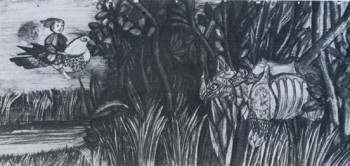 Mickey Rose, an English musicologist, made a fifty minute-long abbreviation of the opera, performed by Berlin Philharmonic, conducted by Karl Boehm, preserving its most vital elements. At the same time the graphics enriches fantastic and folk aspects with expression. It was done with charm, amazing clearness and respect for the music. When the artists use the technique of decoupage paper becomes gold, glass becomes diamond and colours become rich and luminous, like Mozart’s music. It reminds us of such great modern painters as Rouault, Chagall, Picasso, Kandinsky, as well as of oriental wall paintings, Byzantine mosaics, story, creating a naturally composed style, rich in different shades, -where a brilliant visual side interprets and completes Mozart’s wonderful music. Finally the fairy tale aspect predominates over the symbolic aspect, also due to the character of Papageno, who plays a double role: of a paper character and a live narrator (actor Marcello Bartoli). This character in multicoloured feathers reminds its famous classic ancestors. The grandson of Harlequin and Pulcinella becomes the hero of the story, determining its character. Thus the romantic story of Tamino and Pamina concentrates the philosophic sense, which is shown in the form of a fairy tale, and is meant for a demanding audience. But the simple first layer of the film pleases children, like the films “Turandot” and “L’Augellin Belverde”, screened by Gianini and Luzzati in a similar style and technique. About seventy thousand photograms with their immobile and mobile parts, three hundred drawings of the background, creative power and enthusiasm of the authors make a work of art, which is a credit to the Italian cartoon film and deserves emotions, enthusiasm and approval.
Mickey Rose, an English musicologist, made a fifty minute-long abbreviation of the opera, performed by Berlin Philharmonic, conducted by Karl Boehm, preserving its most vital elements. At the same time the graphics enriches fantastic and folk aspects with expression. It was done with charm, amazing clearness and respect for the music. When the artists use the technique of decoupage paper becomes gold, glass becomes diamond and colours become rich and luminous, like Mozart’s music. It reminds us of such great modern painters as Rouault, Chagall, Picasso, Kandinsky, as well as of oriental wall paintings, Byzantine mosaics, story, creating a naturally composed style, rich in different shades, -where a brilliant visual side interprets and completes Mozart’s wonderful music. Finally the fairy tale aspect predominates over the symbolic aspect, also due to the character of Papageno, who plays a double role: of a paper character and a live narrator (actor Marcello Bartoli). This character in multicoloured feathers reminds its famous classic ancestors. The grandson of Harlequin and Pulcinella becomes the hero of the story, determining its character. Thus the romantic story of Tamino and Pamina concentrates the philosophic sense, which is shown in the form of a fairy tale, and is meant for a demanding audience. But the simple first layer of the film pleases children, like the films “Turandot” and “L’Augellin Belverde”, screened by Gianini and Luzzati in a similar style and technique. About seventy thousand photograms with their immobile and mobile parts, three hundred drawings of the background, creative power and enthusiasm of the authors make a work of art, which is a credit to the Italian cartoon film and deserves emotions, enthusiasm and approval.
Frame Grabs &Luzzati & Gianini 19 May 2009 07:58 am
Ali Baba
- Ali Baba is another beautiful film from the Luzzati-Gianini team. The film is adapted from the book by Luzzati done for Pantheon books in 1973. I’ve made some frame grabs:
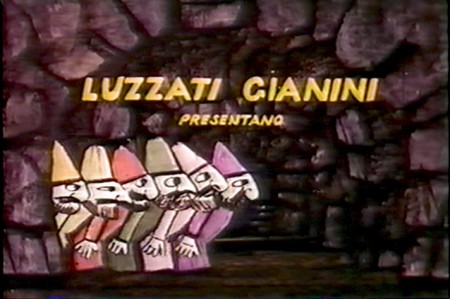
(Click any image to enlarge.)
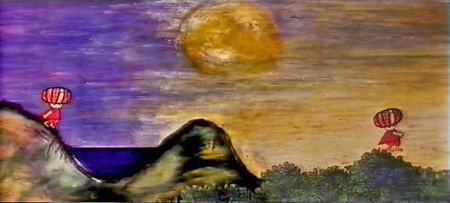
The film includes a lot of pans. Some of them quite long.
Doing cut-out animation, under the camera, with arduous pan movements
was a very tricky operation. You never knew if you were going to have a bump.
Today, in Flash or AfterEffects, you can see it immediately and repair any problem.
Animation Artifacts &Commentary &Luzzati & Gianini &repeated posts 18 May 2009 07:36 am
Giulio Gianini 1927-2009
 – I’ve been something of a fan of the films of Luzzati and Gianini. I’d met Emanuelle Luzzati at a function thrown at the Italian Embassy in New York, years ago. I bought a book by him, and the artist drew a beautiful pen and ink drawing in the frontispiece of the book.
– I’ve been something of a fan of the films of Luzzati and Gianini. I’d met Emanuelle Luzzati at a function thrown at the Italian Embassy in New York, years ago. I bought a book by him, and the artist drew a beautiful pen and ink drawing in the frontispiece of the book.
In 1988, I met Giulio Gianini in Italy during a stay of a couple of pleasant days with an assistant of his at the festival in Treviso, Italy.
Mr. Gianini died this past Saturday, and I wanted to offer a bit of a memorial. Emanuelle Luzzati died January, 2007 and to memorialize that I posted some illustrations and information about the duo with a lot of frame grabs from a number of the Luzzati/Gianini films. It took a few posts, and I left off without wanting to overplay all of the art at my availability.
Luzzati & friend
The Thieving Magpie was the first of their films to receive an Oscar nomination, and it was the first of the frame-grab posts I showcased. I’d like to post it again in honor of Mr. Gianini. He was sick for several years and in particularly bad condition. His death wasn’t a surprise, but it is still an enormous loss.
 1
1  2
2(Click any image to enlarge.)
La Gazza Ladra (The Thieving Magpie) is a Rossini opera about a young maidservant who, accused of stealing a silver spoon, is sentenced to death for her crime.
At the eleventh hour, the real culprit is found to be a magpie.
A cartoon, if ever there was one. With great music!

The film tells a tale wherein a king and his hunters, on a bird hunt, are beaten
by a magpie who steals their gems and ultimately destroys their village.
 4
4  5
5
Luzzati who spent many years designing operas and ballets,
brought his knowledge to animation as the pair adapted several operas often utilizing the overtures of the operas they were adapting.
 6
6  7 The film was nominated in 1964 along with
7 The film was nominated in 1964 along with
Clay, and the Origin of the Species by Eliot Noyes
and the winner, Chuck Jones’ Dot and the Line.
The Sound of Music won the Best Picture Oscar, that year.
 8
8  9 The use of cut-out animation wasn’t mainstream at the time.
9 The use of cut-out animation wasn’t mainstream at the time.
This is years before Terry Gilliam made it somewhat fashionable. All of the
Luzzati-Gianini films were totally inventive and creative within the form they established.
Gianini’s animation was as dreamlike as Luzzati’s exciting designs. The films
look to be designed somewhere between Chagall, Kirchner and
stained-glass windows; the sensibilities are all Luzzati and Gianini.
 Today we have Flash animation which does just about the same thing as cut-out animation, but the form used today is flat and vulgar and cartoony. It might be useful for practitioners of Flash to take a good look at what these two brilliant designer/animators did with a similar form under more complex and arduous methods. Ulltimately, it’s all related.
Today we have Flash animation which does just about the same thing as cut-out animation, but the form used today is flat and vulgar and cartoony. It might be useful for practitioners of Flash to take a good look at what these two brilliant designer/animators did with a similar form under more complex and arduous methods. Ulltimately, it’s all related.
You can get a bit more information about Gianini and Luzzati from the website of the Luzzati Museum in Genova.
Books &Illustration &Luzzati & Gianini 29 Apr 2009 07:42 am
Luzzati’s Magic Fish
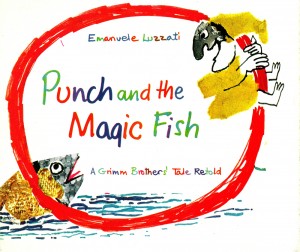 - Last week I posted a book byEmauele Luzzati, The Magic Flute. (Part 1, Part 2)
- Last week I posted a book byEmauele Luzzati, The Magic Flute. (Part 1, Part 2)
This was an adaptation of the feature film he did with Giulio Gianini. Luzzati also did a number of other children’s books (aside from all the animated films, as well as the theater and opera designs he did). None, that I know of, were pure adaptations of his film work. However, he did build on the character Pulcinello (Punch) to develop his story around Grimm tales.
Here’s a version of Punch and the Magic Fish, first published in English in 1972.
Most of the book is done as two-page spreads. I didn’t separate them. As with his past work, Luzzati uses a lot of mixed media. It looks like marker was the primary tool he used.
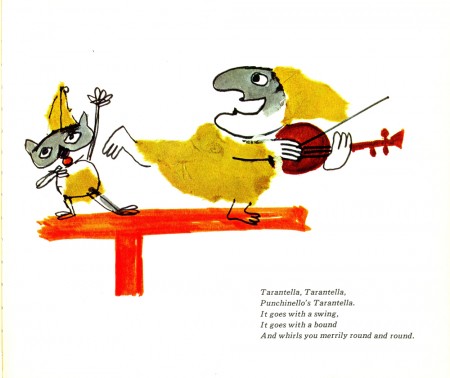 pg 1
pg 1(Click any image to enlarge.)
Books &Illustration &Luzzati & Gianini 17 Apr 2009 07:51 am
The Magic Flute – 2
- This post concludes the images from The Magic Flute, a book by Emauele Luzzati. The illustrations are reworked sketches and drawings done for the animated feature he did with animator, Giulio Gianini in 1978.
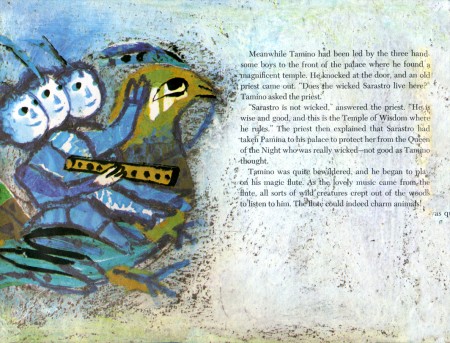 13
13(Click any image you’d like to enlarge.)
Books &Illustration &Luzzati & Gianini 16 Apr 2009 08:06 am
The Magic Flute – 1
- Emanuele Luzzati teamed with animator Giulio Gianini many times to produce some of the most beautiful films of the 60s & 70s. Their feature version of The Magic Flute completed in 1978 was also adapted into a book by Luzzati. He’d done the sets and costumes for a version of the opera in 1963.
The film didn’t get the attention it deserved, and it remains hard to locate. A small snippet is incorporated into a video on YouTube. (The animation doesn’t come on until about a minute of the piece.)
I originally saw the film when it once aired on local WNET (PBS station). It wasn’t repeated and video wasn’t available back then. However, I do have the children’s book which Luzzati published from his designs for the animation.
Here are the first half of the illustrations in the book.
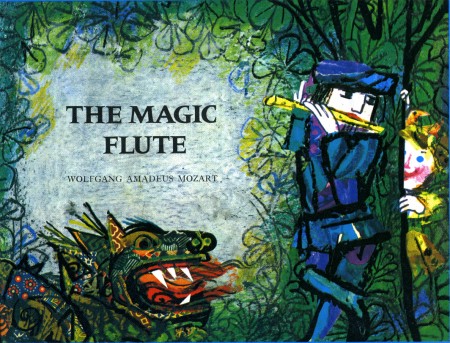
(Click any image to enlarge.)
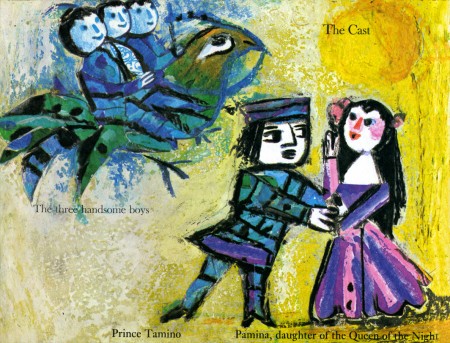 1
1
I left the type in the illustrations, though it’s a bit hard to read.
To be concluded tomorrow.
Articles on Animation &Comic Art &Commentary &Frame Grabs &Luzzati & Gianini 13 Feb 2008 08:51 am
Luzzati – Gianini titles
Two excellent videos are posted on Willym Rome‘s site, Willy or Wont He. They’re film pieces by Emanuele Luzzati and Giulio Gianini. Both films are difficult to find available.
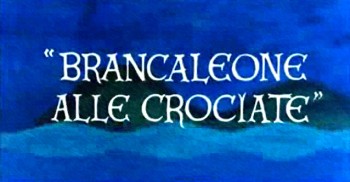 The Cat Duet is a work adapted from an operatic piece that uses much of Rossini’s music even though it’s not considered an opera by the composer. The background of the opera is hazy, but the animated film is a beauty.
The Cat Duet is a work adapted from an operatic piece that uses much of Rossini’s music even though it’s not considered an opera by the composer. The background of the opera is hazy, but the animated film is a beauty.
Brancaleone alle Crociate (Brancaleone at the Crusades) is a title sequence for the film by Mario Monicelli. It stars Vittorio Gassman and is reminiscent of other pieces by Luzzati and Gianini. I’ve made some frame grabs and am posting them below to give a small taste of the work. Go to the site, and view both videos.
See other posts I’ve done on Luzzati and Gianini. They’re all very musical, beautifully designed and cleverly animated films.
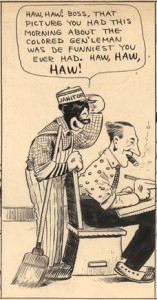 - Craig Yoe posted a wonderful original Mutt & Jeff comic strip on the Arflovers Blog. The strip features cartoonist, Bud Fisher, trying to draw a politically correct strip in 1919. Take a look; it’s hilarious.
- Craig Yoe posted a wonderful original Mutt & Jeff comic strip on the Arflovers Blog. The strip features cartoonist, Bud Fisher, trying to draw a politically correct strip in 1919. Take a look; it’s hilarious.
- Speaking of politically correct strips, there’s a good post about blacks in the current comic strips at The Root. It’s enlightening to read about this stuff in the 21st Century when we’re considering a black man as President. (Go Obama!) Race still matters to some people, unfortunately..
- And speaking about Obama if you haven’t watched the Will I Am song Yes We Can sung to Obama’s New Hampshire speech take the time to look at it. Over a billion people have watched it already. The last half is good. here
You should see it if only to appreciate the anti McCain parody
_______________-_________posted here.
_

_
- For something a little less controversial, check out the new post on the ASIFA Hollywood Animation Archive. It’s a beautiful book illustrated by Gustaf Tenggren. Tenggren, of course, had a big hand in the design of Pinocchio. He was also the creator of The Poky Little Puppy.
_
- Yesterday, John Dilworth showed me the cover of the latest copy of ASIFA International’s magazine, Cartoons. He came across the magazine before I’d received my copy. I was surprised to see my work featured so prominently. That was a treat, I can assure you.
Thanks to the editors, Chris Robinson and John Libbey for the fine choice of cover and to Ray Kosarin for writing it in the first place.
It was even more interesting that Dilworth was the one who animated that cover scene from my film, Abel’s Island.
_
_
Luzzati & Gianini 04 Apr 2007 08:18 am
Pulcinella
 – I received a call from The Guardian in London. The newspaper was doing an obituary for Emanele Luzzati, and they couldn’t find any illustrations to color their report. They’d found some on my blog and wanted to know if they could use them.
– I received a call from The Guardian in London. The newspaper was doing an obituary for Emanele Luzzati, and they couldn’t find any illustrations to color their report. They’d found some on my blog and wanted to know if they could use them.
(Go here to see all Luzzati/Gianini posts.)
Of course, I directed them to Luzzati‘s distributor who could give the clearances they needed.
But I found it all depressing.
This was one of the world’s greatest designers of Operas and Animation. His brilliant animated version of The Magic Flute is a feature that should be in theaters now. Unfortunately, it never made it to theaters (at least, not in the US), and his designs for the opera are equally as stunning.
Years of amazing art he’s produced, and there’s so little – even on-line – that could be readily found for his obituary. I find it confusing. This was the original reason I had for putting so much attention on his work, and the call from the paper pushes me back to do another post. Unfortunately, all I have are frame grabs.
Here is Pulcinella. It is a short that was nominated for the Oscar in 1973. Another cut-out animated film, Frank Film by Frank and Caroline Mouris won the award. The Legend of John Henry by Sam Weiss, produced by Nick Busustow was also nominated.
Like other Luzzati/Gianini films, the score is taken from an opera overture, Rossini’s The Turk in Italy.
The animated film is an abbreviated, caricatured version of the opera. 
Pulcinella (Punch, as in Punch & Judy) is the principal character who dreams himself into a wild nightmare of a dream that leads us through an abstract world. It’s nice to see how the animators/designers play off the puppet character as well as the opera.
I’m just going to post the images without detailing the story. I like it better that way.
There are some 90 images, so it takes some attention to graphics.



(Click any image on the page to enlarge.)
Animation Artifacts &Luzzati & Gianini 09 Feb 2007 07:49 am
Luzzati & Gianini’s – An Italian In Algiers
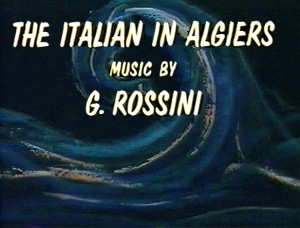 - An Italian In Algiers was one of the more popular films of Emanuele Luzzati and Giulio Gianini. The film was made in 1969 and was, like many of their other films, an adaptation of an opera using the overture as its soundtrack.
- An Italian In Algiers was one of the more popular films of Emanuele Luzzati and Giulio Gianini. The film was made in 1969 and was, like many of their other films, an adaptation of an opera using the overture as its soundtrack.
The opera’s story is about Isabella, an Italian woman, who is shipwrecked in Algiers and has become the apple of the eye of Mustafa, the bei of Algiers. Although he has a bevy of wives and slave women, he wants Isabella. Through cunning, she manages to escape Algiers with her young lover and a number of the slaves of Mustafa.
Essentially, the short film tells this same story – but without words.
Here, then, are a number of frame grabs. The film without the music.
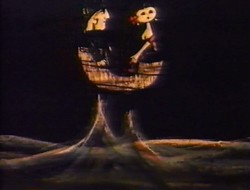
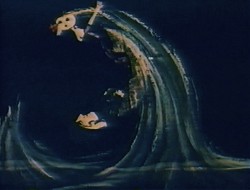
(Click any image to enlarge.)
Swept away by angry waves as they sail from Venice, newlyweds Lindoro and Isabella are washed ashore on the African coast.
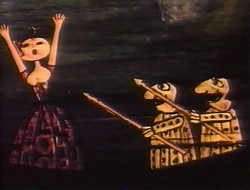
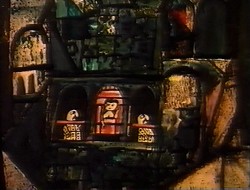
Isabella is captured and taken to a private space not too far from the other slaves and wives of . . .
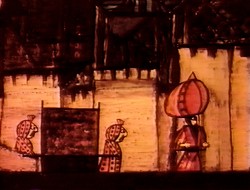
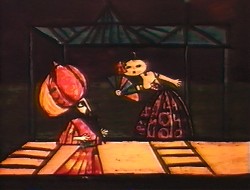
Mustapha visits Isabella, and she pretends to be interested.
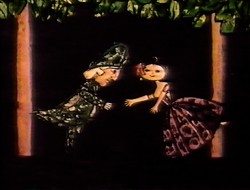
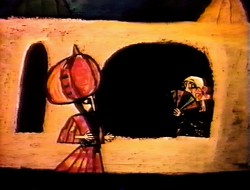
She is visited by her new husband, Lindoro. Mustapha learns of their visits.
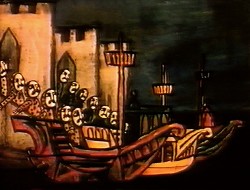
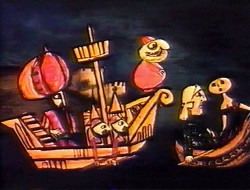
The film ends in a madcap sea chase with Isabella and Lindoro escaping as the curtain comes down.
